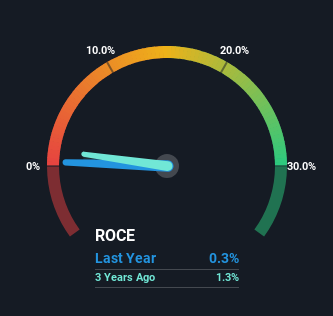Zhejiang Ming Jewelry (SZSE:002574) May Have Issues Allocating Its Capital

If we want to find a stock that could multiply over the long term, what are the underlying trends we should look for? Ideally, a business will show two trends; firstly a growing return on capital employed (ROCE) and secondly, an increasing amount of capital employed. Put simply, these types of businesses are compounding machines, meaning they are continually reinvesting their earnings at ever-higher rates of return. However, after investigating Zhejiang Ming Jewelry (SZSE:002574), we don't think it's current trends fit the mold of a multi-bagger.
Return On Capital Employed (ROCE): What Is It?
Just to clarify if you're unsure, ROCE is a metric for evaluating how much pre-tax income (in percentage terms) a company earns on the capital invested in its business. The formula for this calculation on Zhejiang Ming Jewelry is:
Return on Capital Employed = Earnings Before Interest and Tax (EBIT) ÷ (Total Assets - Current Liabilities)
0.0034 = CN¥16m ÷ (CN¥7.9b - CN¥3.1b) (Based on the trailing twelve months to March 2024).
So, Zhejiang Ming Jewelry has an ROCE of 0.3%. In absolute terms, that's a low return and it also under-performs the Luxury industry average of 6.5%.
View our latest analysis for Zhejiang Ming Jewelry

Historical performance is a great place to start when researching a stock so above you can see the gauge for Zhejiang Ming Jewelry's ROCE against it's prior returns. If you'd like to look at how Zhejiang Ming Jewelry has performed in the past in other metrics, you can view this free graph of Zhejiang Ming Jewelry's past earnings, revenue and cash flow.
What The Trend Of ROCE Can Tell Us
In terms of Zhejiang Ming Jewelry's historical ROCE movements, the trend isn't fantastic. To be more specific, ROCE has fallen from 1.8% over the last five years. Although, given both revenue and the amount of assets employed in the business have increased, it could suggest the company is investing in growth, and the extra capital has led to a short-term reduction in ROCE. And if the increased capital generates additional returns, the business, and thus shareholders, will benefit in the long run.
While on the subject, we noticed that the ratio of current liabilities to total assets has risen to 39%, which has impacted the ROCE. If current liabilities hadn't increased as much as they did, the ROCE could actually be even lower. While the ratio isn't currently too high, it's worth keeping an eye on this because if it gets particularly high, the business could then face some new elements of risk.
Our Take On Zhejiang Ming Jewelry's ROCE
While returns have fallen for Zhejiang Ming Jewelry in recent times, we're encouraged to see that sales are growing and that the business is reinvesting in its operations. However, despite the promising trends, the stock has fallen 23% over the last five years, so there might be an opportunity here for astute investors. As a result, we'd recommend researching this stock further to uncover what other fundamentals of the business can show us.
One final note, you should learn about the 4 warning signs we've spotted with Zhejiang Ming Jewelry (including 2 which are potentially serious) .
While Zhejiang Ming Jewelry may not currently earn the highest returns, we've compiled a list of companies that currently earn more than 25% return on equity. Check out this free list here.
If you're looking to trade Zhejiang Ming Jewelry, open an account with the lowest-cost platform trusted by professionals, Interactive Brokers.
With clients in over 200 countries and territories, and access to 160 markets, IBKR lets you trade stocks, options, futures, forex, bonds and funds from a single integrated account.
Enjoy no hidden fees, no account minimums, and FX conversion rates as low as 0.03%, far better than what most brokers offer.
Sponsored ContentValuation is complex, but we're here to simplify it.
Discover if Zhejiang Ming Jewelry might be undervalued or overvalued with our detailed analysis, featuring fair value estimates, potential risks, dividends, insider trades, and its financial condition.
Access Free AnalysisHave feedback on this article? Concerned about the content? Get in touch with us directly. Alternatively, email editorial-team (at) simplywallst.com.
This article by Simply Wall St is general in nature. We provide commentary based on historical data and analyst forecasts only using an unbiased methodology and our articles are not intended to be financial advice. It does not constitute a recommendation to buy or sell any stock, and does not take account of your objectives, or your financial situation. We aim to bring you long-term focused analysis driven by fundamental data. Note that our analysis may not factor in the latest price-sensitive company announcements or qualitative material. Simply Wall St has no position in any stocks mentioned.
About SZSE:002574
Zhejiang Ming Jewelry
Engages in the research, development, design, production, and sale of jewelry products primarily in Mainland China.
Adequate balance sheet low.


